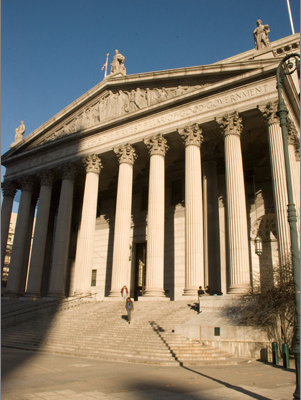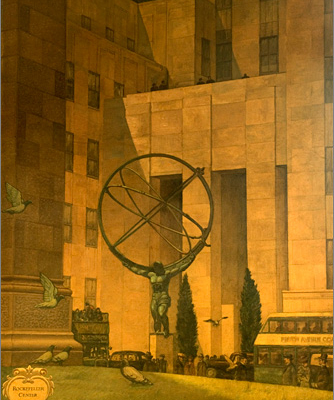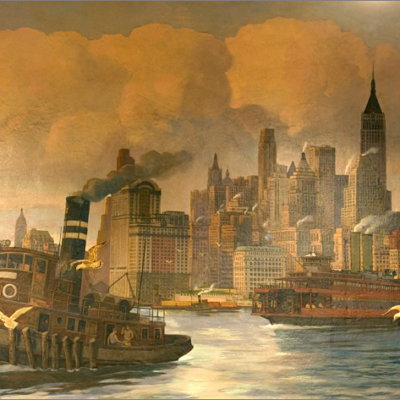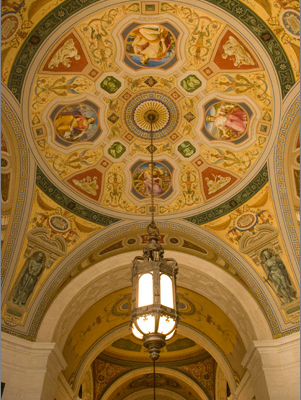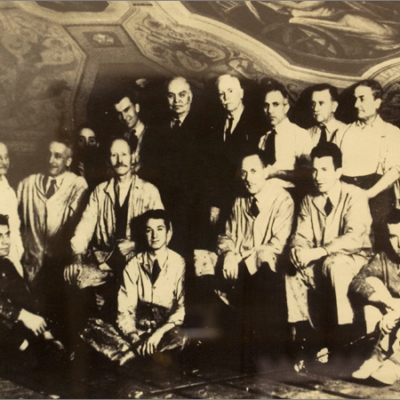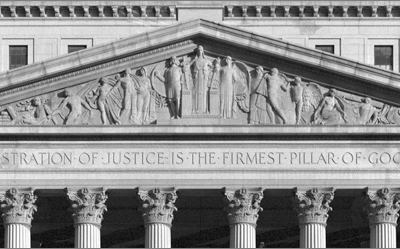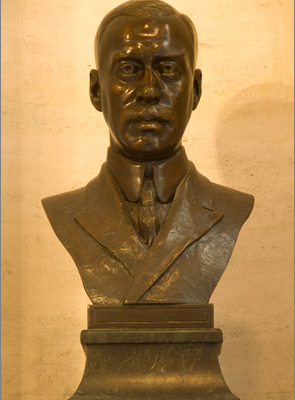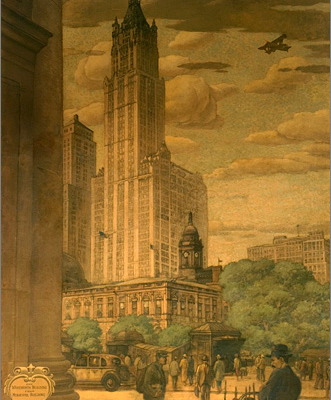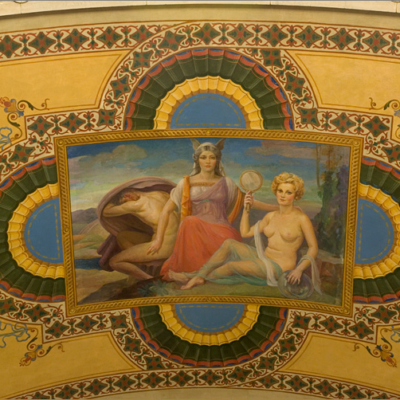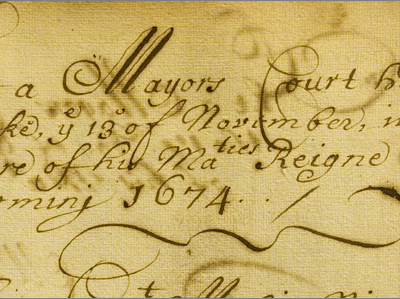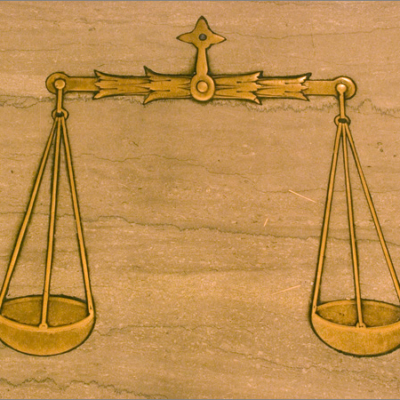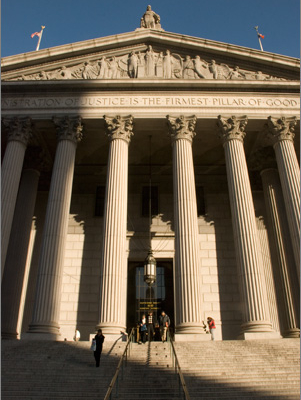The Supreme Courthouse (New York County Court), located at 60 Centre Street, overlooks Foley Square. The building houses the Supreme Court and the Office of the County Clerk. The building was designated as a New York City Landmark in 1966.
The New York County Court was formerly housed in the old Tweed Courthouse. When additional space was needed, the New York State Legislature created a “Courthouse Board” to select an architect and design. The Boston architect Guy Lowell won the competition in 1913 with his design for a circular building. The cost estimate for this design was an astronomical 20 to 30 million dollars. World War I brought construction delays and the design evolved into a smaller, more modest Temple of Justice. Lowell modified the design to a hexagonal building with a cost estimate of 7 million dollars. Work finally began in 1919. The Roman classical style chosen was popular for courthouse architecture in the first decades of the 20th century and compliments the nearby Municipal Building.
The courthouse was the first major New York commission for the well-known Boston architect Guy Lowell (1870-1927). He designed the Boston Museum of Fine Arts and the building plan for Philips Academy at Andover, Massachusetts. He was also a landscape architect and designed formal gardens for Andrew Carnegie and J. Pierpont Morgan in New York.
The courthouse was dedicated and opened in February of 1927. Luminaries presents at the dedication ceremony included then Chief Judge of the New York Court of Appeals Benjamin Cardozo and Associate Judges of the Court of Appeals Frederick E. Crane and Irving Lehman. Sadly, Guy Lowell died two weeks prior to the event.
The most prominent exterior architectural feature of the courthouse is its famous portico. The courthouse rises above a 100-foot wide flight of 32 steps to an imposing colonnade of sixteen granite fluted Corinthian columns, ten of which are aligned directly beneath the portico’s triangular pediment. Above the center columns are engraved words of George Washington from a 1789 letter to attorney-general Randolf: “The true administration of justice is the firmest pillar of good government.”
The triangular pediment is 140-feet long and contains 14 classical figures in high relief. Atop the pediment are three statues representing Law, Truth and Equity, the work of master sculptor Frederick H. Allen.
The monumental character of the exterior continues on the interior, with its central rotunda and radial corridors. The Rotunda is 200 feet in circumference and rises 75 feet to a cupola 30 feet in height, 20 feet across, with 10 stained glass windows and clerestory. It was not until the mid-1930s, however, that work commenced on the renowned Courthouse murals. Under the sponsorship of the federal government’s Works Progress Administration, WPA artists with Attilio Pusterla standing front center wearing suit Attilio Pusterla and his crew of artists painted a series of murals on the vestibule ceiling and on the rotunda dome. The general theme of the vestibule ceiling is the administration of justice and includes many figures ranging from Truth and Error, to Protection and Security. The dome in the main rotunda is entitled ìLaw Through the Ages.î It consists of six “lunettes” which depict pivotal developments in the history of the law over the millennia, including Moses, Hammurabi, and Justinian.
The extraordinary work of Attilio Pusterla and his crew of WPA artists continued on the fourth floor of the courthouse in the jury assembly rooms with the painting of the exceptional murals gracing the walls. Jury rooms 448 and 452 are decorated with murals depicting historical and contemporary scenes of New York. In room 448, the artist Robert K. Ryland produced 11 panels depicting New York’s early history. The panels include Henry Hudson’s voyage on the Half-Moon; an Indian settlement; Broad Street circa 1660s; and two additional panoramas of Manhattan in the 18th century. Of great artistic importance are the nine murals in Room 452. While several artists contributed to these works, the predominant piece is by Pusterla. This mural scene depicts a panoramic view of the Manhattan skyline and harbor.
Over the years, water leaks and general neglect threatened the building and its artistic masterpieces. Through a collaborative effort, undertaken in the 1980s and continuing into the 1990s, among leaders in the Court, at the Bar, and in New York City government, a major County Courthouse conservation campaign was undertaken and successfully completed. Among court leaders most involved in this project was County Clerk Norman Goodman.
Norman Goodman, in addition to championing the cause for restoration, has also given equal attention to preserving the rich historical record of the archives of the New York County Clerk. Dating back to the 17th century, the historical court documents remained unattended after Mayor Fiorello LaGuardia abolished the Office of the Commissioner of Records in the 1930s. The records are now preserved under the guardianship of the County Clerk. In the 1990s, Mr. Goodman hired two full-time archivists and created a not-for-profit organization to assist the preservation effort.
While the County Courthouse serves as one of the largest courts of original, unlimited, civil jurisdiction in the United States, it is perhaps best know to the general public as the “stage set” for the television series Law and Order and the Hollywood classic film from the 1950s Twelve Angry Men.
Notwithstanding its many attributes, the greatest contribution of this very busy court has been and always will be its contribution to the jurisprudence of our Country, City, State, and Nation.
Special Thanks to The Department of Citywide Administrative Services and the team of archivists and Clerks of the New York County Courthouse for information about the history of the courthouse contained in this description.
Read More!
From the Tweed Courthouse to the “New” New York County Courthouse
by John F. Werner, Retired Chief Clerk
60 Centre Street–A Look Back, with Some Ruminations About the Future
by John F. Werner, Retired Chief Clerk
and
Robert C. Meade, Jr., Retired Deputy Clerk

